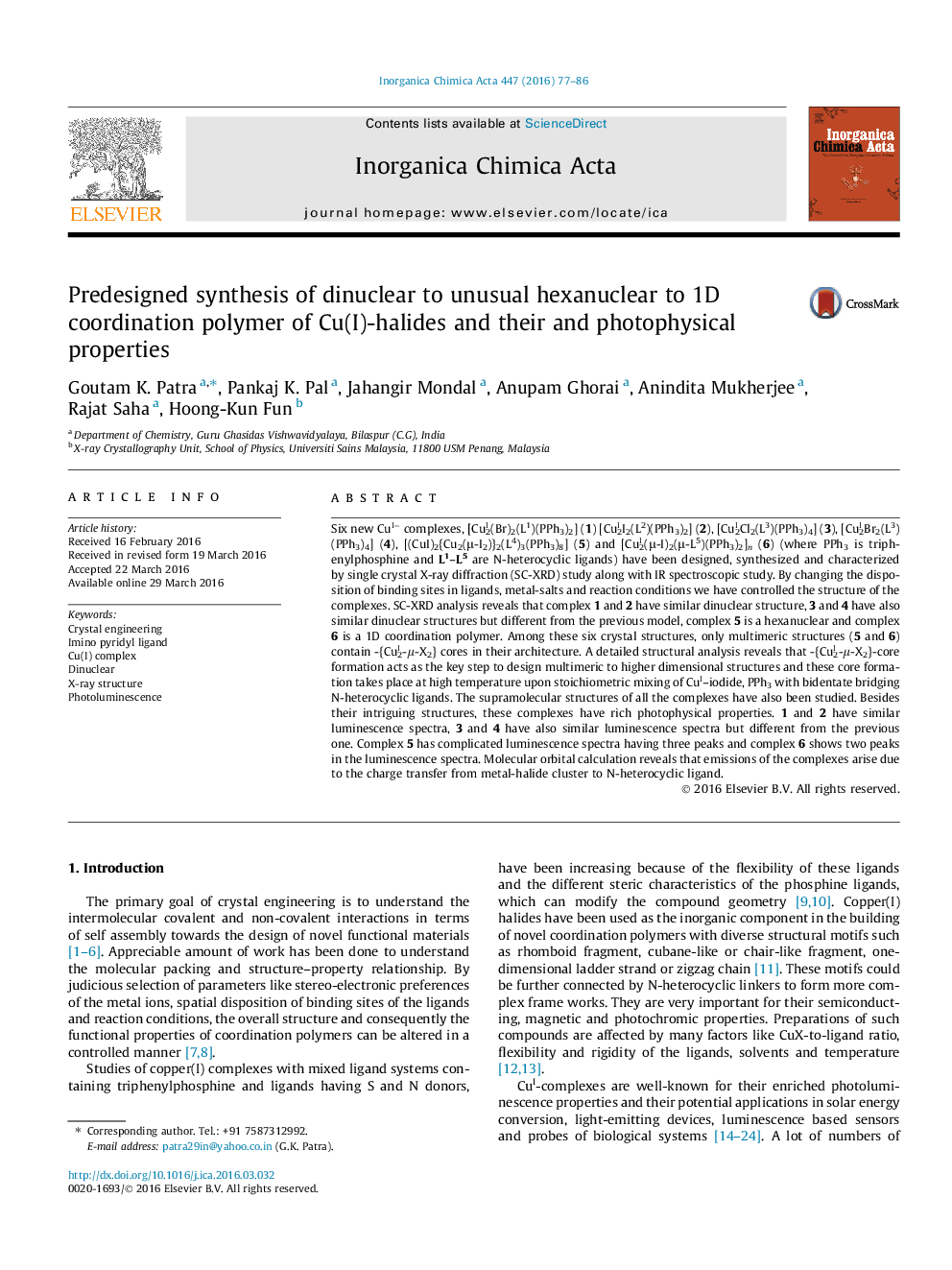| Article ID | Journal | Published Year | Pages | File Type |
|---|---|---|---|---|
| 1307481 | Inorganica Chimica Acta | 2016 | 10 Pages |
•Six ternary complexes of CuX (X = Cl, Br, I) with PPh3 and polydentate imino-pyridyl ligands have been synthesised.•One complex (1) is hexanuclear.•It is (1) having bridging and non-bridging iodide ion.•Complexes exhibit photo luminescence.•Example of crystal engineering.
Six new CuI− complexes, [CuI2(Br)2(L1)(PPh3)2] (1) [CuI2I2(L2)(PPh3)2] (2), [CuI2Cl2(L3)(PPh3)4] (3), [CuI2Br2(L3)(PPh3)4] (4), [(CuI)2{Cu2(μ-I2)}2(L4)3(PPh3)8] (5) and [CuI2(μ-I)2(μ-L5)(PPh3)2]n (6) (where PPh3 is triphenylphosphine and L1–L5 are N-heterocyclic ligands) have been designed, synthesized and characterized by single crystal X-ray diffraction (SC-XRD) study along with IR spectroscopic study. By changing the disposition of binding sites in ligands, metal-salts and reaction conditions we have controlled the structure of the complexes. SC-XRD analysis reveals that complex 1 and 2 have similar dinuclear structure, 3 and 4 have also similar dinuclear structures but different from the previous model, complex 5 is a hexanuclear and complex 6 is a 1D coordination polymer. Among these six crystal structures, only multimeric structures (5 and 6) contain -{CuI2-μ-X2} cores in their architecture. A detailed structural analysis reveals that -{CuI2-μ-X2}-core formation acts as the key step to design multimeric to higher dimensional structures and these core formation takes place at high temperature upon stoichiometric mixing of CuI–iodide, PPh3 with bidentate bridging N-heterocyclic ligands. The supramolecular structures of all the complexes have also been studied. Besides their intriguing structures, these complexes have rich photophysical properties. 1 and 2 have similar luminescence spectra, 3 and 4 have also similar luminescence spectra but different from the previous one. Complex 5 has complicated luminescence spectra having three peaks and complex 6 shows two peaks in the luminescence spectra. Molecular orbital calculation reveals that emissions of the complexes arise due to the charge transfer from metal-halide cluster to N-heterocyclic ligand.
Graphical abstractBy changing the counter anion in metal salt, disposition of binding sites in ligands and reaction conditions we have synthesized six copper(I)-based complexes of various dimensions: dinuclear to hexanuclear to 1D coordination chain structure in a predefined-controlled manner and studied their photophysical properties with theoretical interpretations. And also we have shown that {CuI2-μ-X2}-core formation is the key strategy to design multimeric and higher dimensional structures of copper(I) and also developed the synthetic condition under which this core formation takes place selectively.Figure optionsDownload full-size imageDownload as PowerPoint slide
